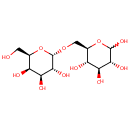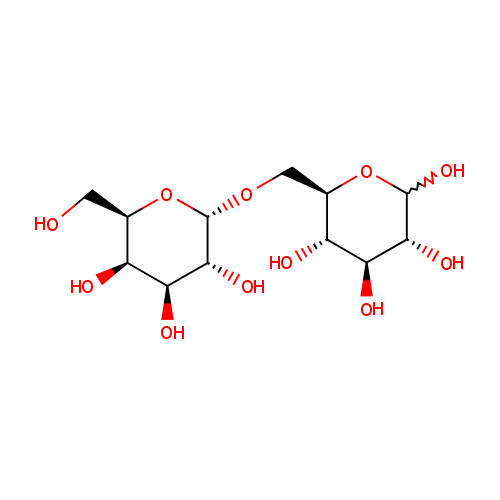| References: |
- Almeida IC, Milani SR, Gorin PA, Travassos LR: Complement-mediated lysis of Trypanosoma cruzi trypomastigotes by human anti-alpha-galactosyl antibodies. J Immunol. 1991 Apr 1;146(7):2394-400. Pubmed: 1706399
- Barboza Junior MS, Silva TM, Guerrant RL, Lima AA: Measurement of intestinal permeability using mannitol and lactulose in children with diarrheal diseases. Braz J Med Biol Res. 1999 Dec;32(12):1499-504. Pubmed: 10585631
- Colby SM, Harrington DJ, Russell RR: Identification and genetic characterisation of melibiose-negative isolates of Streptococcus mutans. Caries Res. 1995;29(5):407-12. Pubmed: 8521444
- Furukawa K, Ying R, Nakajima T, Matsuki T: Hemagglutinins in fungus extracts and their blood group specificity. Exp Clin Immunogenet. 1995;12(4):223-31. Pubmed: 8919354
- Gibbons RJ, Qureshi JV: Inhibition of adsorption of Streptococcus mutans strains to saliva-treated hydroxyapatite by galactose and certain amines. Infect Immun. 1979 Dec;26(3):1214-7. Pubmed: 528053
- Kanehisa, M., Goto, S., Sato, Y., Furumichi, M., Tanabe, M. (2012). "KEGG for integration and interpretation of large-scale molecular data sets." Nucleic Acids Res 40:D109-D114. Pubmed: 22080510
- Keseler, I. M., Collado-Vides, J., Santos-Zavaleta, A., Peralta-Gil, M., Gama-Castro, S., Muniz-Rascado, L., Bonavides-Martinez, C., Paley, S., Krummenacker, M., Altman, T., Kaipa, P., Spaulding, A., Pacheco, J., Latendresse, M., Fulcher, C., Sarker, M., Shearer, A. G., Mackie, A., Paulsen, I., Gunsalus, R. P., Karp, P. D. (2011). "EcoCyc: a comprehensive database of Escherichia coli biology." Nucleic Acids Res 39:D583-D590. Pubmed: 21097882
- Nicolopoulou A, Zoumbou K, Papageorgacopoulou N, Papapetropoulou M: Metabolic and compositional changes in Escherichia coli cells starved in seawater. Microbiol Res. 1994 Nov;149(4):343-50. Pubmed: 7842233
- Rietra PJ, Van den Bergh FA, Tager JM: Properties of the residual alpha-galactosidase activity in the tissues of a Fabry hemizygote. Clin Chim Acta. 1975 Aug 4;62(3):401-13. Pubmed: 809216
- Schmid, K., Schmitt, R. (1976). "Raffinose metabolism in Escherichia coli K12. Purification and properties of a new alpha-galactosidase specified by a transmissible plasmid." Eur J Biochem 67:95-104. Pubmed: 786627
- Sharma A, Ahmed H, Allen HJ: Isolation of a melibiose-binding protein from human spleen. Glycoconj J. 1995 Feb;12(1):17-21. Pubmed: 7795409
- Steuer MK, Steuer M, Bonkowsky V, Gabius HJ, Hofstadter F: Characterization of sugar receptor expression by neoglycoproteins in oral and oropharyngeal squamous cell carcinomas. Eur Arch Otorhinolaryngol. 1995;252(5):292-7. Pubmed: 7576587
- Tomita K, Nagura T, Okuhara Y, Nakajima-Adachi H, Shigematsu N, Aritsuka T, Kaminogawa S, Hachimura S: Dietary melibiose regulates th cell response and enhances the induction of oral tolerance. Biosci Biotechnol Biochem. 2007 Nov;71(11):2774-80. Epub 2007 Nov 7. Pubmed: 17986780
- van der Werf, M. J., Overkamp, K. M., Muilwijk, B., Coulier, L., Hankemeier, T. (2007). "Microbial metabolomics: toward a platform with full metabolome coverage." Anal Biochem 370:17-25. Pubmed: 17765195
- Vaughan HA, Loveland BE, Sandrin MS: Gal alpha(1,3)Gal is the major xenoepitope expressed on pig endothelial cells recognized by naturally occurring cytotoxic human antibodies. Transplantation. 1994 Oct 27;58(8):879-82. Pubmed: 7524207
- Winder, C. L., Dunn, W. B., Schuler, S., Broadhurst, D., Jarvis, R., Stephens, G. M., Goodacre, R. (2008). "Global metabolic profiling of Escherichia coli cultures: an evaluation of methods for quenching and extraction of intracellular metabolites." Anal Chem 80:2939-2948. Pubmed: 18331064
- Wu AM, Song SC, Chen YY, Gilboa-Garber N: Defining the carbohydrate specificities of aplysia gonad lectin exhibiting a peculiar D-galacturonic acid affinity. J Biol Chem. 2000 May 12;275(19):14017-24. Pubmed: 10799474
|
|---|


